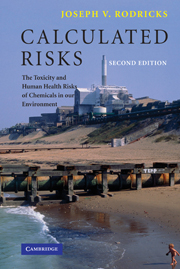Book contents
- Frontmatter
- Contents
- Preface to the first edition
- Preface to the second edition
- List of abbreviations
- Prologue
- 1 Chemicals and chemical exposures
- 2 From exposure to dose
- 3 From dose to toxic response
- 4 Toxic agents and their targets
- 5 Carcinogens
- 6 Identifying carcinogens
- 7 Risk assessment I: some concepts and principles
- 8 Risk assessment II: applications
- 9 Risk assessment III: new approaches, new problems
- 10 Risk assessment IV: the courtroom
- 11 The management of risk
- 12 A look ahead
- Sources and recommended reading
- Index
1 - Chemicals and chemical exposures
Published online by Cambridge University Press: 25 August 2009
- Frontmatter
- Contents
- Preface to the first edition
- Preface to the second edition
- List of abbreviations
- Prologue
- 1 Chemicals and chemical exposures
- 2 From exposure to dose
- 3 From dose to toxic response
- 4 Toxic agents and their targets
- 5 Carcinogens
- 6 Identifying carcinogens
- 7 Risk assessment I: some concepts and principles
- 8 Risk assessment II: applications
- 9 Risk assessment III: new approaches, new problems
- 10 Risk assessment IV: the courtroom
- 11 The management of risk
- 12 A look ahead
- Sources and recommended reading
- Index
Summary
It is perhaps too obvious to point out that everything we can see, touch, smell, and taste is a chemical or, more likely, a mixture of many different chemicals. In addition, there are many chemical substances in the environment that cannot be detected with the senses, but only indirectly, by the sophisticated instruments scientists have devised to look for them. The number of different chemicals in and on the earth is unknown, but is surely in the many millions. During the past 125 years scientists have been successful in creating hundreds of thousands of compounds that do not occur in nature, and they continue to add to the earth's chemical stores, although most of these synthesized chemicals never leave the research scientists' laboratories.
For both historical and scientific reasons chemists divide up the universe of chemicals into inorganic compounds and organic compounds. The original basis for classifying chemicals as “organic” was the hypothesis, known since the mid nineteenth century to be false, that organic chemicals could be produced only by living organisms. Modern scientists classify chemicals as “organic” if they contain the element carbon. Carbon has the remarkable and almost unique property that its atoms can combine with each other in many different ways, and, together with a few other elements – hydrogen, oxygen, nitrogen, sulfur, chlorine, bromine, fluorine, and a few more – can create a huge number of different molecular arrangements. Each such arrangement creates a unique chemical.
- Type
- Chapter
- Information
- Calculated RisksThe Toxicity and Human Health Risks of Chemicals in our Environment, pp. 11 - 27Publisher: Cambridge University PressPrint publication year: 2006



